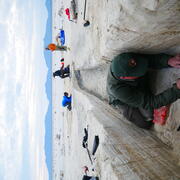Drylands
Drylands, characterized by water scarcity, comprise 83% of DOI-managed lands. Drylands are highly vulnerable to erosion by wind and water and are affected by land use (e.g., grazing) and disturbance (e.g., fire). The Ecosystems Land Change Science Program conducts research to understand the primary drivers of change in dryland soils and vegetation to inform management decisions.













